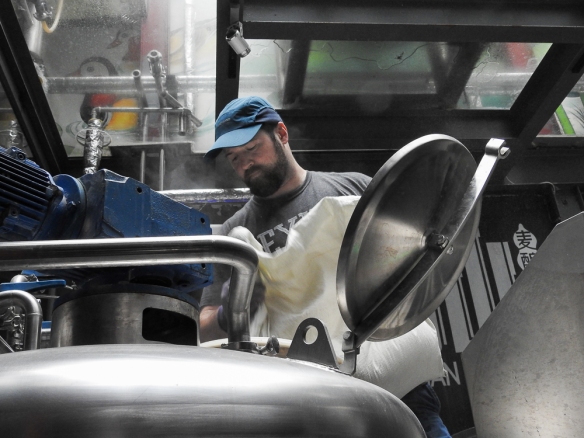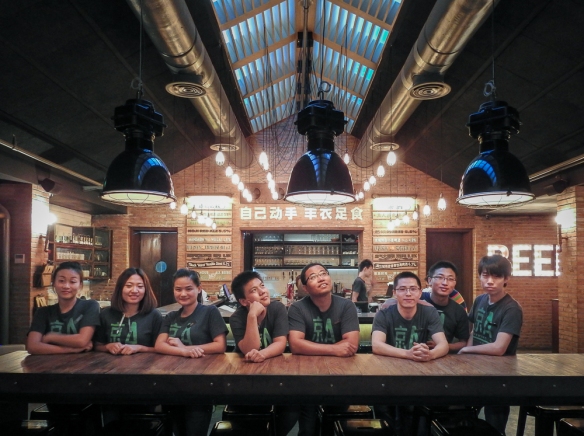
Xian Brewing brewer, Jon Therrian, adds malt to his brew kettle.
As in North America, the craft beer phenomenon in China is not a fad. it’s a cultural transformation being driven by a generational shift in the consumer market. With the growing influence of urban Millennials in the marketplace, their needs and preferences are increasingly driving trends.
Craft beer is an aspirational lifestyle product that is attractive to China’s new middle class. It’s an “affordable luxury”, as Garrett Oliver of Brooklyn Brewing is fond of saying. Although craft beer lacks the status of wine or Scotch whisky, its appreciation requires all the sophistication of wine tasting but at a fraction of the cost.
Product novelty is important to Millennials. Therefore, drinking a generic light lager designed to appeal to the lowest common denominator holds little interest. Small-batch brewing, on the other hand, embraces continual product innovation. You might say, then, that macro beer is a gastronomic cul-de-sac, craft beer an adventure.
Quality is also an issue. With a number of prominent tainted food scandals in China, people are growing more concerned with what they ingest. Knowing where your food and drink comes from – and who produces it – helps to build trust, which is one factor in a growing trend towards buying local.
Together, these factors have driven an astonishing transformation in China over the last five years. From its humble beginnings in Beijing (北京 Běijīng) and Shanghai (上海 Shànghǎi), the craft beer revolution has now spread from Xi’an (西安 Xī’ān) to Xiamen (厦门 Xiàmén), Dali (大理 Dàlǐ) to Qiqiha’er (齐齐哈尔 Qíqíhā’ěr). There is even Tibetan craft beer in Shangri-la (香格里拉 Xiānggélǐlā).
Further signs of China’s arrival on the global craft beer stage are the growing number of international beer collaborations. These include respected global brands, such as Mikkeller, Nøgne Ø, Renaissance, and Baird. China’s craft brewers are also winning medals at international beer competitions. In this year’s World Beer Cup, Boxing Cat was the first Mainland Chinese craft brewery to place in the WBC winner’s circle.
Despite these promising developments, craft beer has barely registered, as far as China’s overall beer consumption statistics are concerned. For the revolution to continue building, a number of challenges must be overcome.

Customers enjoy tasting flights at 京A Brewery’s taproom.
Education
Enjoying craft beer is much more than just simply switching brands. It’s a cultural change. Cultural transformations usually don’t happen overnight; often they take decades. Take coffee as an example. Remember when all you had to do to order a coffee was to say to the waitress, “I’ll have a coffee.”? Then Starbucks came along and taught us a new language. Ordering coffee hasn’t been the same. Now it requires a longer conversation.
Not only does craft beer have a new vocabulary to learn, it also has a whole new behaviour to acquire. One doesn’t just belt back craft beer like mass-market light lager. To appreciate the brewer’s craft, you need to slow down to employ all the senses. People must learn the optimum way to enjoy a particular beer. Over time, your palate broadens, your beer preferences acquire more of a seasonality, and you start to understand beer’s affinity for pairing with food.
As you can see, thinking drinking requires a considerable amount of education. This knowledge is acquired from family and friends, books, magazines, newspapers, blogs, festivals, brewmasters dinners, and well-trained staff at brewpubs, restaurants, and taphouses. To expand the revolution in China, a lot more people will need to be trained, especially the media and those in the hospitality industry who will reach a larger number of people than the average person.
Government Regulation
Like the tech industry, the North American brewing renaissance had its roots in the garage. Homebrewers, fed up with the blandness and homogeneity of industrial lager, sought to create beer with more flavour, complexity, and variety. In order to do so, however, homebrewing had to be legal.
Then, to make the leap from homebrewing to commercial brewing typically meant opening a brewpub. This combination of an industrial enterprise with a hospitality establishment often required changing laws and creating new regulations to make it possible.
Taxation has also hindered the growth of the craft beer industry in many places. If there isn’t a graduated structure in place that recognizes the financial differences between small businesses and large enterprises, craft brewing may not be viable. However, once governments understand the economic benefits that craft brewing can bring and make the appropriate regulatory changes, the growth in the industry is immediate, as has been shown in South Korean and Alberta, for example.
In China, one major limitation on the expansion of craft brewing is that a brewery is unable to acquire a license to distribute bottled beer if it cannot package at least 12,000 bottles an hour. When you consider the amount of volume this represents, and the resources needed to both produce and sell that amount of beer, you’ll understand that is a significant barrier to entry.
Another regulation hindering China’s craft beer revolution is the requirement that all domestically-produced bottled beer must be filtered and pasteurized. As both of these processes reduce flavour and mouthfeel, craft brewers want to avoid them in order to deliver to their customers the most flavoursome beer possible. While draught beer faces no such restrictions, the large majority of Chinese drink bottled beer. This requirement also makes it impossible to sell locally-produced bottled-conditioned beer. Imported beer faces no such restrictions if filtration and pasteurization are not required in their country of origin.
Ingredients
With a brewing industry geared towards economies of scale, China’s farmers and maltsters have adapted to serve a virtual monoculture. They are currently woefully incapable of providing the range and quality of specialty malts and hops that craft brewers require. Domestic supplies of yeast strains are also limited in variety and do not meet craft brewers’ needs.
If Chinese growers and producers are to benefit from the craft beer revolution and adapt to the changing beer market, they will need to make significant investments to alter their operations to these essentials. Improvements in the quality of domestic ingredients and production practices will be imperative. Given the growing global demand for specialty malts and hops, and the pressures on agriculture from the affects of global warming, it is difficult to say how much longer the increasing number of craft brewers in China can rely on imported raw materials.
Distribution
Unfiltered, unpasteurized craft beer without chemical preservatives is a highly perishable product that requires much more care in transportation and storage than mass-market lager if it is to maintain its flavour and freshness to the point of consumption. It must be adequately protected from heat and light. Especially during the hot months of the year, this means cold storage.
Refrigeration is currently lacking in China’s beer supply chain. Therefore, the greater the distance a beer is sold from source, the less certain one can be of its freshness and quality. This is unacceptable for craft brewers who want to ensure their customers are experiencing their beer as it is meant to be and paying a premium for it. Investments and eduction are also needed in China’s craft beer logistics systems.

Slow Boat Brewery in Beijing offers a wide range of beer styles on draught.
Beer Service
Given the importance of education in driving China’s craft beer revolution, pub and restaurant owners must ensure their staff is suitably trained to properly serve beer and to guide their customers in the art of beer appreciation. Beyond knowledge of various beer styles and terminology, an understanding of proper serving temperatures and use of appropriate glassware is also necessary.
Another shift taking place is the growth of draught beer sales. Relative to Europe and North America, China’s consumption of draught beer is low. However, as Chinese craft breweries are limited in their ability to distribute bottled beer, unless they meet the government’s high minimum production threshold, most of their production is consumed close to source as draught.
While drinking draught beer is usually preferable for its freshness and lack of the effects of pasteurization, cleanliness of draught systems and service practices can significantly affect beer quality. For the consumption of draught beer to grow in China, a service industry will need to evolve that provides hospitality establishments with installation services, draught service best practices education, and draught system maintenance. This will be critical as all it takes to ruin a superb beer is dirty draught lines.
The Road Ahead
Industrial lager in China has now reached the point of diminishing returns. In response, the conglomerates view consolidation and “premiumization” as short-term remedies. As we’ve seen with the multinational brewers, they merge with, and acquire, other breweries to achieve higher economies of scale in an attempt to maintain their profits and stock price. However, with the cultural change coming from Millennials, sales of light lager will continue to fall.
“Premiumization” is the next tactic. That is, conglomerates introduce “premium” products in an attempt to offer something new and of higher perceived status. In reality, this is more of a marketing ploy than a genuine offer of a distinct product. New branding, more expensive packaging, micro bubbles, same blandness. It’s putting lipstick on a pig. Snow Super Premium 11°, for example, is starting to sound desperate. Can we expect an Extra, Ultra, or Extreme Super Premium? Again, there will be no lasting positive impact on the bottom line.
If you can’t beat ’em, join ’em! That doesn’t necessarily mean a Chinese industrial brewer will actually make something that closely approximates a craft beer. The first offer of a product other than a minor variation of pale lager is usually a dark beer, like Yanjing Dark or Tsingtao Stout. Then there’s the fruit beer. Snow, Yanjing, and Zhujiang each have a pineapple beer. Tsingtao decided to be different by creating a spirulina beer. The popularity of wheat beer has also spawned its macro variants. However, they, too, are poor imitations of the original style.
“Crafty” beer is a wolf in sheep’s clothing. It’s macro beer gone stealthy. Simply create an irreverent, indie-like brand for what is still a mass-produced product, only don’t mention anywhere that it is made by an industrial brewer. Blue Moon from MillerCoors and Shock Top by AB InBev are two prominent examples. We’ll see if a Chinese conglomerate chooses to go this route.
Multinational brewers have also bought craft breweries, but then hollowed them out by reducing their beer range and cutting back on ingredients to reduce costs. That approach has usually resulted in failure. Instead, they are now buying larger, successful craft breweries and investing in sales growth of brands they consider to have the greatest growth and profit potential.
Chicago’s Goose Island is a good example of this. They were bought by AB InBev in 2011. Since then, they’ve been growing and expanding into international markets. In May this year, they formally entered the Chinese market with a Migration Week marketing campaign. Unlike most imported craft beer brands in China that rely on agents, Goose Island has its own local marketing and sales team that was trained in the United States. When all the other tactics have proved lacklustre, this may be how the multinationals succeed at increasing their profits in the world’s largest beer market.

京A Brewery’s flagship bar and restaurant in Beijing.
That still leaves plenty of room for growth for local craft brewers. However, if the various challenges I have outlined above are not overcome, they will continue to curb the rate and extent of China’s craft beer revolution. This means that in the next five to ten years, we may see more brewpubs open throughout the country, but few production breweries with a greater capability of supplying a growing customer base. Will there be enough brewpubs to meet the demand? Or will foreign breweries exporting to China supply the excess and scoop up profits that would otherwise go into further developing China’s domestic craft beer industry?
I’ve seen first-hand how the meteoric rise of craft beer in my home province of British Columbia in Canada was boosted by municipal and provincial governments recognizing the economic potential in the industry. They modified regulations to facilitate its growth. The impact has been considerable, not only for the brewing industry but in agriculture, manufacturing, hospitality & tourism, media, transportation, and even education. The same is possible in China.
Photos courtesy of Brian K. Smith Photography.

Pingback: CBCE Set to Become China’s Premier Craft Beer Market Place | The Great Hop Forward